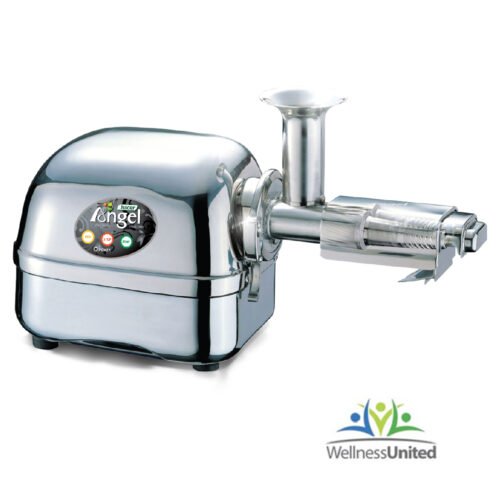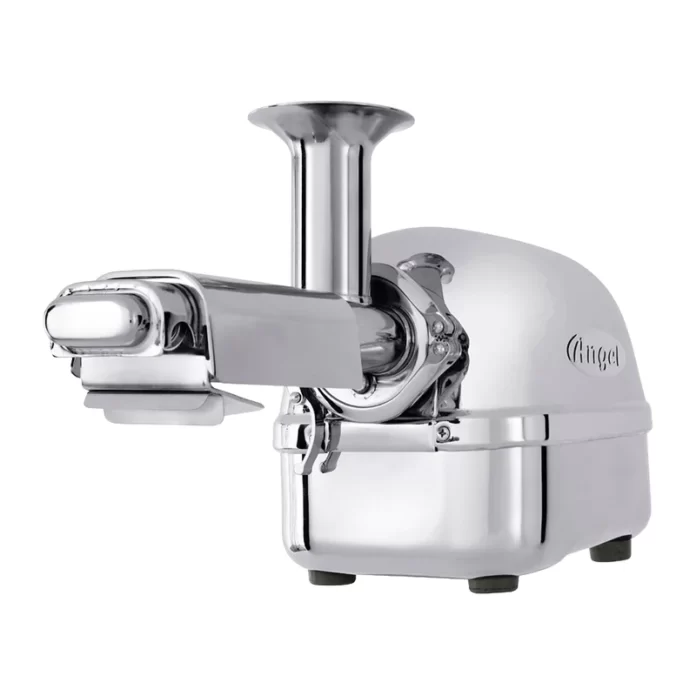Juicing has become a popular trend in the health and wellness world, and for good reason. It’s an easy and delicious way to get your daily dose of fruits and vegetables. And if you’re serious about juicing, investing in a stainless steel juicer is a must. Not only does it provide durability and efficiency, but it also produces higher-quality juice. But if you’re new to using a stainless-steel juicer, you may be feeling a bit overwhelmed. Don’t worry, we’ve got you covered.
Understanding Your Stainless-Steel Juicer
At first glance, a stainless-steel juicer might seem complex, but its operation is quite straightforward once you familiarize yourself with its components and function. Primarily, a stainless-steel juicer consists of a few key parts: a motor, a feed chute, a strainer, and a juice and pulp collector. The motor is the heart of your juicer, powering the entire process. Depending on your model, this could be a fast-spinning centrifugal force motor or a slow-rotating masticating one.
The feed chute is where you insert your fruits and vegetables, which are then pressed or ground, depending on your juicer type. The strainer, usually made from stainless steel or a similarly durable material, separates the juice from the pulp. This component is especially important as it has the job of extracting the maximum amount of juice from your produce while leaving behind the pulp. Your juicer will also have separate containers to collect the juice and the pulp. Some models feature a pulp ejector that continuously expels the pulp into its container, allowing for non-stop juicing.
You may find other accessories with your stainless-steel juicer such as a plunger to safely push down the produce, or a cleaning brush to aid in the maintenance of your juicer. Knowing the basic mechanics of your stainless-steel juicer can make your juicing experience more intuitive and efficient, ensuring you use the appliance to its fullest potential. Remember, for any specific operations or assembly instructions, it’s always best to refer to your manufacturer’s manual.
Benefits of a Stainless-Steel Juicer
Choosing a stainless-steel juicer comes with several advantages. One of the standout benefits is its durability. These juicers are built to last, often outliving their plastic counterparts, making them a worthy investment for your kitchen. The stainless-steel construction also withstands the acidity of fruits and vegetables, which can sometimes damage other materials. Another perk of stainless-steel juicers is their ease of cleaning. The non-porous nature of stainless steel does not harbor bacteria and is resistant to staining.
This makes maintaining hygiene standards much easier and also contributes to the longevity of the appliance. Stainless-steel juicers are generally designed with high-performance motors, capable of handling both soft and hard produce. This versatility allows you to extract juice from a wide array of fruits and vegetables, enhancing your juicing options and nutritional intake. Aesthetically, stainless-steel juicers offer a sleek and modern look that complements most kitchen decor styles.
They often possess a high-end finish, which can elevate the appearance of your countertop. These juicers are eco-friendly. Stainless steel is recyclable, and by choosing a stainless-steel juicer, you are contributing to less plastic waste, aligning with a more sustainable lifestyle. Lastly, the use of a stainless-steel juicer can lead to improved health. Having a reliable juicer at your disposal encourages the consumption of fresh, homemade juices. This allows you to take in more nutrients from fruits and vegetables, contributing to better overall health.
 Cleaning and Maintaining Your Juicer
Cleaning and Maintaining Your Juicer
Preserving the performance and longevity of your stainless-steel juicer is highly reliant on proper cleaning and regular maintenance. Always remember to clean your juicer immediately after each use to prevent pulp and juice residues from drying, which makes them more challenging to remove and may affect your juicer’s functionality. Start by disassembling your juicer carefully. Rinse each component under warm running water. Utilize a cleaning brush, particularly for crevices and other hard-to-reach places such as the strainer.
For a more comprehensive clean, mild dish soap and a soft cloth can be employed. Ensure to scrub gently to avoid scratching the stainless-steel surface. Once you’ve thoroughly cleaned each part, it’s crucial to dry them completely before reassembling them to avert any potential moisture damage. This can be done by patting them dry with a towel or letting them air-dry on a clean dish rack.
The act of maintaining your juicer involves regularly checking the condition of its parts. Check for any signs of wear and tear, especially on the blade or auger and the motor. Consult your manufacturer’s guide or contact customer service if you notice anything unusual. This routine cleaning and maintenance not only keeps your juicer in optimal condition but also ensures the taste and quality of your juice remain uncompromised. With a well-maintained stainless-steel juicer, you’re on the right path to enjoying fresh and nutritious homemade juices for years to come.
How to Use Your Stainless Steel Juicer?
Start by assembling your stainless steel juicer following the manufacturer’s instructions. Once it’s assembled, plug it in and ensure that the power switch is in the off position. It’s time to prepare your produce. Depending on your juicer and the type of fruit or vegetable you’re juicing, you may need to peel and cut your produce into pieces small enough to fit into the feed chute. Always remove any hard seeds or pits that could damage your juicer. Now, turn on your juicer. Begin feeding your produce down the chute slowly, using the plunger if provided, to press them down towards the blade or auger.
Never use your hands or any other tool to push down the produce as it could lead to injury. As you add more produce, the juice will start flowing into the juice collector while the pulp gets ejected into its separate container. Make sure to keep an eye on these containers and empty them when necessary, especially if your juicer doesn’t have an automatic pulp ejection feature. It’s important to note that for optimal juice yield and quality, alternate between soft and hard produce. For instance, if you’re making a juice with apples and spinach, start with an apple piece, follow with some spinach, and repeat.
Some Delicious Juice Recipes to Try
There’s nothing quite like a refreshing glass of homemade juice to kick start your day. Here are some simple yet delicious recipes to try out with your stainless-steel juicer.
Classic Green Juice:
For a nutrient-packed start to your day, try juicing 2 green apples, a handful of spinach, 4 celery stalks, 1 cucumber, and a small piece of ginger. This concoction is not only incredibly healthy but also delightfully refreshing.
Citrus Sunrise:
To create a zesty wake-me-up juice, combine the juice of 2 oranges, 1 grapefruit, and a squeeze of lime. This tangy blend is a great source of Vitamin C, perfect for boosting your immune system.
Beetroot Bliss:
This deep-red blend is as delicious as it is beautiful. To make this juice, you’ll need 2 beetroot, 2 carrots, and 1 apple. This earthy and sweet mix is rich in antioxidants and perfect for a mid-afternoon pick-me-up.
Pineapple Paradise:
For a tropical treat, juice half a pineapple, 1 mango, and a small piece of ginger. This vibrant and sweet juice is sure to transport you to a sunny beach with each sip.
Spiced Carrot Delight:
Spice up your juicing routine with this unique blend. Juice 5 carrots, 1 apple, a small piece of ginger, and a dash of turmeric. This warming juice is packed with vitamins and has a lovely spicy kick.
Tips for Getting the Most Out of Your Juicer
To optimize the performance of your stainless-steel juicer, always opt for ripe and fresh produce. These not only yield more juice but also offer superior flavor and nutrition. It’s essential to consume the juice as soon as it’s extracted to maintain the optimal nutritional value, given that the nutrient content in juice tends to decrease over time. However, if storing your juice is unavoidable, place it in an airtight container and refrigerate it immediately, ensuring consumption within a day.
One common mistake made by many juicers is to overlook the value of the pulp. Instead of discarding it, try incorporating this nutrient-rich byproduct into various dishes. The pulp is an excellent source of fire and can be used in a myriad of ways. Add it to your smoothies or soups for an extra nutritional boost, or even use it in baking recipes as a healthy ingredient. For garden enthusiasts, it can also be composted to enrich your soil.
Remember, efficiency and creativity in your juicing process can significantly enhance your juicing experience. So, always make the most out of your juicing efforts by utilizing every part of your produce and the resulting byproducts. Explore different ways to make your juicing routine even more enjoyable and beneficial, all the while maximizing the potential of your stainless-steel juicer.
FAQs
Q: Why isn’t my juicer extracting as much juice as it should?
A: The amount of juice extracted can be affected by different factors such as the ripeness of your fruits and vegetables. If they aren’t ripe enough, they may not produce as much juice. Also, ensure that stainless steel juicer is properly cleaned after every use as any leftover pulp or residue can obstruct the juicing process. Lastly, if you’ve checked all these and the problem persists, it may be time to have your juicer serviced.
Q: My juicer seems to be making a lot of noise. Is this normal?
A: While it’s common for juicers to make some level of noise, especially when processing harder fruits and vegetables, excessive noise could be a sign of a problem. You may want to check if there’s anything lodged in the juicer or if it’s assembled correctly. If the loud noise continues even after these checks, you may want to consult with a professional.
Q: Can I juice all types of fruits and vegetables?
A: Most fruits and vegetables can be juiced, but certain items like bananas and avocados, due to their creamy texture, might not juice as efficiently. It’s always best to refer to your appliance’s manual for any specific guidelines.
Q: Should I peel and remove seeds from my fruits and vegetables before juicing?
A: This generally depends on the type of fruit or vegetable and your juicer’s specifications. Although most juicers can handle small seeds and peels, you might want to remove them to avoid a bitter taste in your juice or potential damage to your juicer.
Conclusion
Investing in a stainless-steel juicer not only provides the opportunity to indulge in flavorful, freshly squeezed juices, but it also serves as a gateway to a wellness-oriented lifestyle. By prioritizing diligent care and upkeep, your juicer can become a long-lasting kitchen companion. So, venture into the exciting realm of juicing, reap the bountiful health advantages it offers, and elevate your culinary experiences.
| Other Good Articles to Read |
| skank blogs |
| unreal blogs |
| tba blogs |
| all city forums |
| dany blogs |
| refuge blogs |
| the music blogs |
| key forums |
| the big blog theory |
| joe blogs |
| blogs 4 me |
| Blogs Emon |
| Related Business Listings |
| Contact Directory |
| Local Business Profiles |
